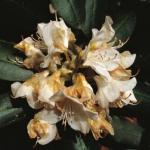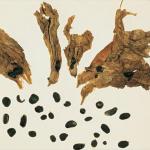Ovulinia Petal Blight
The fungus Ovulinia azaleae causes Ovulinia petal blight.
Host Plants
Ovulinia azaleae infects the flowers of both native and introduced azalea and rhododendron (Rhododendron species) as well as mountain laurel (Kalmia latifolia), especially where there are heavy morning fogs.
Description
Ovulinia petal blight fungus only attacks flowers. Typical symptoms begin as small pallid spots on colored petals and brown spots on white petals. The spots often quickly expand in size causing whole flowers to become slimy and fall apart easily.
Drooping, wet flower petals remain attached or tumble down onto nearby leaves. Black, ovoid fungal resting structures about the size of a grain of rice are often visible within the mass of browned petals.
Disease Cycle
The Ovulinia fungus survives the winter as black resting structures on or just beneath the soil surface around the base of Rhododendron infected the previous season. With fog, heavy dew, or spring rains, they produce fruiting structures that release spore into the air. Spores that land on wet petals germinate immediately and infect them. Wet, cool conditions result in rapid production of more spores on these infection sites. Then these spores are spread via rain splash, wind, and pollinating insects to flowering Rhododendron in the area. Resilient, black fungal resting structures begin to develop within days of flower collapse. Most of these structures fall to the ground underneath the affected plant, where the Ovulinia fungus survives until the next flowering period.
Management Strategies
Remove diseased flowers and clean up flower litter on ground around the base of the plants after flowering is through to reduce inoculum. When buds begin to open, irrigate in a manner that minimizes the period of petal wetness. Space plants well and prune them to provide good air circulation and sunlight penetration. If petal blight is a persistent problem on a site, gradually replace susceptible plants with resistant plants. If combined with implementation of the suggested cultural practices, high value plants can also benefit from fungicide protection. Apply fungicides to flower buds and directly onto the ground around the plants in spring before flowering begins. As long as the flowers continue to open, repeat applications at intervals specified on the label. Test fungicide on a few flowers before spraying entire plant; some fungicides may discolor flowers.
Written by: Dan Gillman
Revised: 09/2011
Photos: J. L. Peterson and R. G. Linderman, Diseases of Woody Ornamentals and Trees. APS Press.

